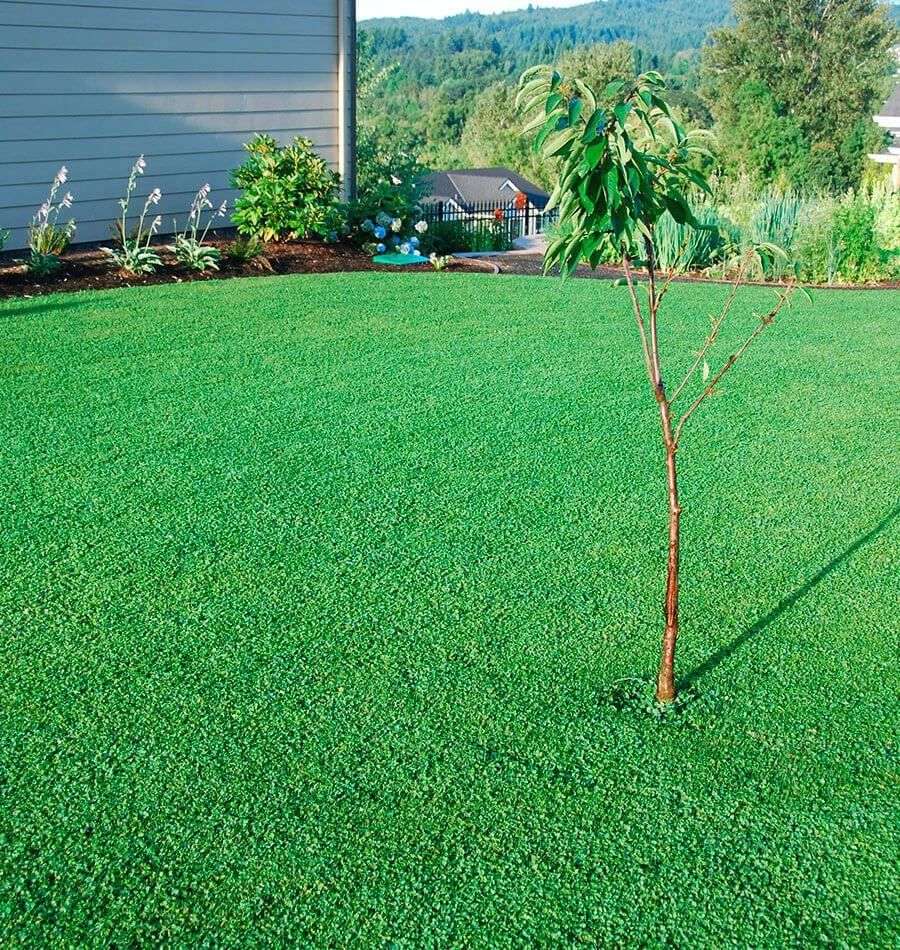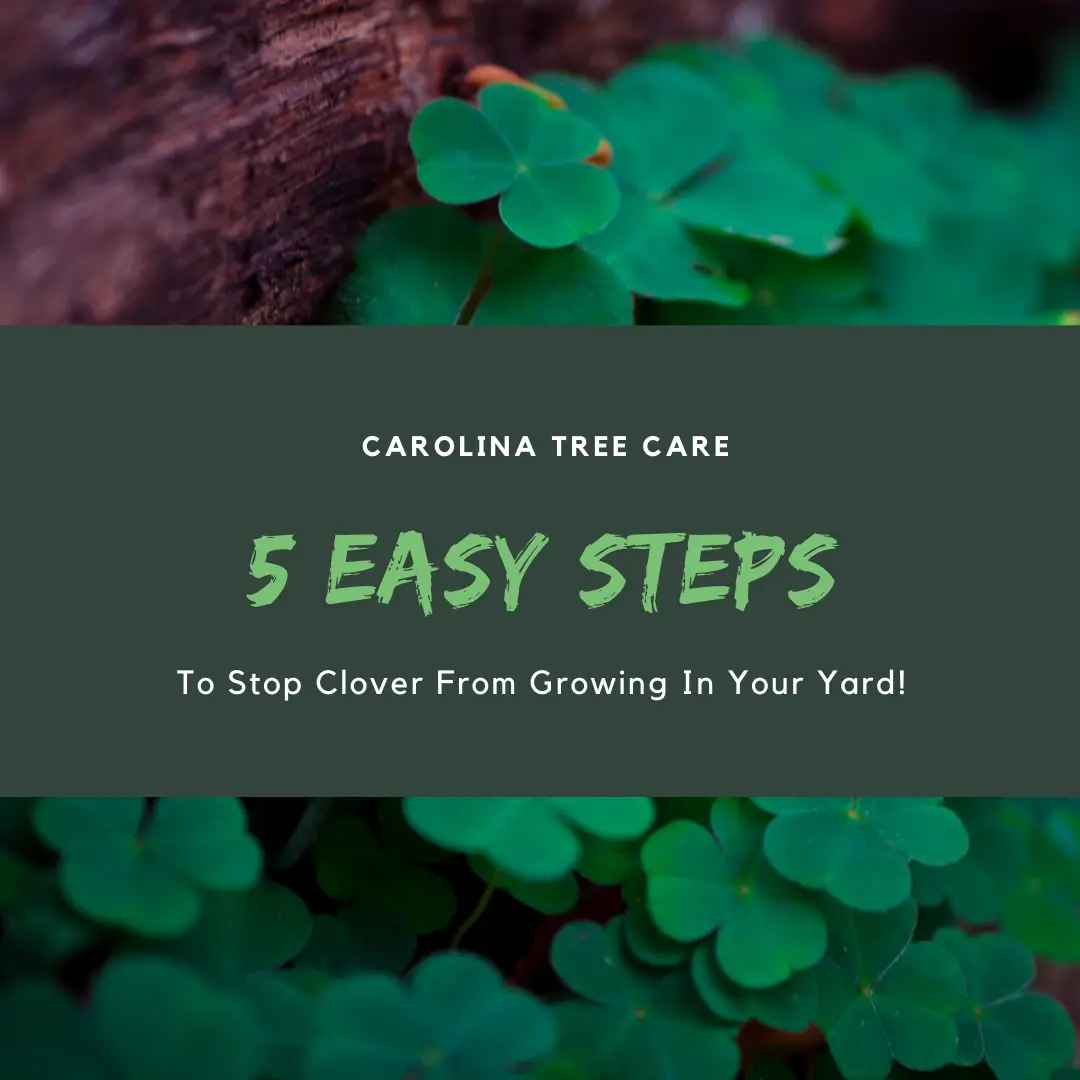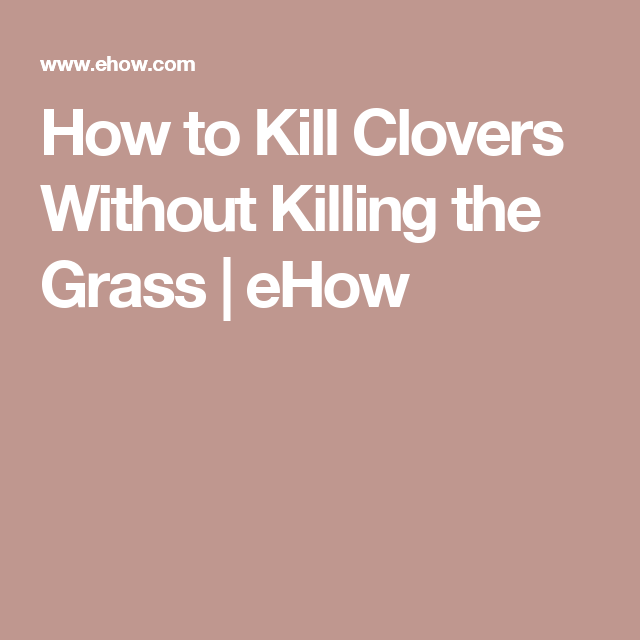Clover Lawns Can Spread Without High Maintenance
Will clover take over grass? If your grass is thin or brown, its possible that clover can take over those areas of your lawnespecially if theyre shady. However, because clover adds nitrogen to the soil, its more likely that it will help your grass stay healthy instead of competing with the rest of your lawn.
Deprive It Of Oxygen And Sunlight
You can kill clover by blocking it from all oxygen and sunlight. Take plastic sheeting or a garbage bag and place it over the patch, securing the corners with rocks to make sure it doesnt fly up. This should get rid of the clover in a few weeks. Be mindful that this approach will also kill any grass that gets under the plastic.
Why Is Crabgrass Taking Over My Lawn
Weeds are better adapted to adverse growing conditions than most lawn grasses. Shallow, frequent watering encourages shallow root growth, making the grass more likely to suffer during periods of heat and drought. That kind of stress can lead to thin patches and bare spots that crabgrass will take advantage of.
Recommended Reading: How To Naturally Kill Weeds In Lawn
Valuable Methods To Kill Clover But Not Grass
Identifying clover is relatively straightforward. If your lawn is spotted with pink or white flowers that attract bees and butterflies, you have clover. Another easy way to determine if it is white clover marring your luscious green lawn is by their leaves. White clover features three leaves that form a petal shape.
Each of these leaves is about half an inch long, with a white crescent shape prominent on each one. White clover generally blooms in the early spring or late fall. The best time to get rid of clover is when it first begins to bloom.
Which Type Is Best

Dwarf white clover attracts bees and other wildlife. If desired, you can control blooming by mowing.
The two varieties most commonly used in lawns are Dutch white clover and more recently, micro-clover . Heres what you need to know about these options:
Dutch white clover:
- Usually needs reseeding after 2-3 years.
- Stays green all year round .
- Blooms when mature, providing food for bees.
- Does best with 4-6 hours of sun daily.
- Seeds at a rate of about 1lb per 1000 square feet.
Micro-clover:
- Is fairly shade tolerant, though does best in areas with sun.
- Can be mowed shorter than white clover.
- Is tolerant to more foot traffic.
- Produces about 90% fewer blooms than Dutch white clover.
- Turns brown in winter due to dormancy period.
- Seeds at a rate of about 1lb to 300-600 square feet.
You May Like: How Does Lawn Love Work
Poor Soil Nutrient Levels
Clover thrives in soil with poor nutrient levels, especially nitrogen. Grass needs nitrogen to be able to grow well, but clover, as mentioned previously, can obtain nitrogen from the air and essentially make its own fertilizer.
As mentioned previously, organic lawn fertilizer can help boost these nitrogen levels and encourage healthy grass growth while discouraging clover growth.
How To Get Rid Of White Clover
Getting rid of white clover starts with a healthy lawn. Clover will grow in areas of low nitrogen and where competition from other plants is small, so making sure that your lawn are well fertilized will not only help desirable grass and plants to grow and keep out white clover, but will also make the soil less friendly to white clover.
In flower beds, clover can be kept at bay by using a thick layer of mulch. This will keep the seeds from germinating.
If white clover is already established in your yard, controlling it can either be done through hand pulling or by using an herbicide. In either case, while killing the white clover already in your lawn is easy, you need to understand that killing white clover seeds is not. The seeds can survive high heat, low temperatures and can stay dormant for years before germinating. Whichever method you choose for getting rid of white clover, you can expect to be doing it once a year to control the white clover plants that emerge from the seeds.
You May Like: How Much Is Sunday Lawn Care
Use A Natural Weed Killer
Perhaps the most popular natural weed killer, vinegar is a great option to try if youre wondering how to get rid of clover. Mix a solution of one part water, one part vinegar and a couple drops of dish soap, add it to a spray bottle, then douse the clover. It may take a few weeks of frequent applications, but this natural blend wont harm grass or other plants, and is safe for use around kids and pets, too.
Once the solution has done its job, youll want to put grass seed down in any empty spots where there used to be clover in your lawn.
Should I Get Rid Of It On My Lawn
The simple answer would be a yes. You should get rid of clover immediately because it would disturb the grass. The lawn cannot be hardy, robust, and healthy.
If you want a more complicated answer, you do not have to know how to get rid of clover because it can be beneficial.
As said before, clover can prevent other weeds to grow. Then, this plant becomes a natural fertilizer.
You May Like: How Often Can You Apply Scotts Turf Builder Lawn Food
What Will Kill Clover But Not The Lawn
Lawn weedkillers can kill clover but not the lawn although more than one application can be needed. As clover self-seeds, the process is most likely to need repeating in spring.
You will see homemade weedkillers that contain vinegar recommended online, but vinegar can kill lawn grass along with the clover so we dont advise using this method.
If the patches of clover arent extensive, simply removing them by hand will avoid harm to the lawn.
Read Also: How Much To Aerate Lawn
How To Identify Clover In Your Yard
There are three types of clover that are most commonly found in lawns: white clover, red clover, and microclover. White and red clover are easily identified by their sphere-shaped clusters of tiny blooms and trio of petal-shaped leaves, each leaf bearing a white crescent or a V shape and measuring approximately one-half inch in size. The clover plant normally grows to no more than four to six inches in height although it can reach as much as 12 inches in height.
White clover can be found blooming from early spring until late fall. Red clover begins to bloom in late March and continues into April and can continue to bloom into early summer. Microclover is identified by leaves that are approximately half the size of white and red clover leaves. Once microclover has been mowed it may grow back at only one-third its original size. Microclover has significantly fewer flowers than red or white clover and its growth is denser and more far-reaching than the red or white varieties.
Microclover looks more uniform than other varieties of clover found in lawns, especially after its flowers have been removed by mowing. It grows lower to the ground than its counterparts. The fact that all varieties of this plant tend to grow close together makes it easy to spot clover patches in your yard.
Don’t Miss: When To Apply Spring Lawn Fertilizer
How To Remove Clover
The most effective method of preventing clover from dominating your lawn is to maintain a dense and healthy lawn. Thick lawns are more easily able to crowd out weeds such as clover and prevent them from taking hold. .
There are also a few strategies you can try to get rid of existing clover in your lawn without using herbicides.
Feed you lawn well
Clover will flourish in lawns which have low nitrogen and fertility levels. Unfertilised grass gives clover an advantage as it can produce its own fertiliser, whereas grass cant. If there is sufficient nitrogen in your soil to keep your lawn healthy, the clover will struggle to survive. Clover will be much less of a problem if you fertilise your lawn with a good organic fertiliser during spring to ensure optimum nitrogen levels. To see Horsham Turfs range of lawn fertilisers, click here.
If youre not sure about your soils nitrogen levels, you can conduct a pH soil test to determine if nitrogen is lacking, or take a soil sample to your local lawn care provider to find out the same thing.
Mow high
It can be tempting to set your mower blades lower than normal to scalp the clover, but this will only stress your grass instead. Low-growing clover with its shallow roots has no problem being mowed short, although your grass wont love it. Mow high and leave your lawn over 3 inches tall, to give your grass the advantage. The longer grass will shade the weed and prevent it from growing.
Remove it by hand
Organic treatment
What Does Clover In My Lawn Mean

In most cases, when you see clover growing in your lawn it means that there isnt enough nitrogen. Clover is a legume plant, much like beans, lucerne or alfalfa, that actually draws nitrogen from the air, which it stores in its roots. When the roots die back, the soil draws in the nitrogen. But when your lawn already has enough nitrogen, the clover starts to struggle.
Clover growth can also be a sign that your lawn has been mown too short, is underfed or has been overwatered. All of these issues can be addressed by practising proper lawn care.
Recommended Reading: How To Get Rid Of Nematodes In Lawns
How To Get Rid Of Clover In Your Lawn
When Clover begins taking over lawns it tells us something very important about our lawn health, and most importantly about the health of our soils.
Also when we begin seeing Clover in lawns, we often see that our lawns themselves may also be turning brown or yellow in colour, as well as possibly having slowed growth and looking generally in poor overall health.
How To Remove Clover From Your Lawn
Clover or trefoil are common names for flowering plants in the legume or pea family.
A number of clovers and clover-like species can be a persistent nuisance in lawns, especially as they have a strong resistance to weedkillers.
Clovers are perennial weeds which are easily recognised by their trifoliate leaves.
You can find clover all over your garden, especially on lawns.
You May Like: Where To Buy Corn Gluten For Lawns
Spread Corn Meal Gluten
Cornmeal gluten will not kill existing weeds, however, it does have the ability to prevent the growth of new weeds by drying out the new weed seedlings roots before it has the chance to grow. Cornmeal gluten has the additional benefit that its also a source of nitrogen, further enhancing its ability to prevent weed growth. Take note that for this method, the timing of the application is crucial. If the conditions of the soil are too wet when you apply the corn gluten, the treatment wont have any effect. When applied in the right conditions, the treatment should remain effective for five to six weeks, after which it will need to be reapplied to continue doing its job. Try using the Indian Head Yellow Corn Meal for an organic alternative to pre-emergent weed killer.
Adjust Your Mowing Height
Mowing over clover with a lawnmower is a temporary way to control clover growth. Most people think that lowering their mowers height, so it sits closer to the ground is the most effective way to control clover. The opposite is true.
Clover is a low-growing weed and offers a shallow root system. Allowing your grass to grow taller blocks the sunlight clover needs to grow.
You May Like: How To Estimate Lawn Mowing Jobs
Kill The Clover Organically
There is a great organic weed killer on the market that kills weeds in your lawn, without killing the grass. If you spray this organic weed killer on Clover, it will weaken the Clover without harming the surrounding lawn, giving your grass the advantage it needs to outcompete the Clover. Captain Jack’s Lawnweed Brew is the name of the product and we’ve had great success using it to eliminate Clover and help grass thrive.
Why Do You Have So Much Clover In Your Lawn
Clover is a perennial plant that grows aggressively. It thrives wherever it finds a favorable condition. Contrary to common perception, clover is also beneficial to your garden.
For example, the white clover has a broadleaf and grows along with common grass. It can grow in more robust areas such as poorly drained soil or too shady areas where other vegetation may find it challenging to grow.
The other species of clover is red clover that grows taller than white clover and blooms small purple flowers. Clover is a natural fertilizer as it contains bacteria that convert nitrogen into the fertilizer.
This ability of clover to fix nitrogen from the air allows clover to grow in nitrogen-poor soil. While other plants may struggle to grow properly due to low nitrogen in the ground, the clover finds space and less competition to thrive in any harsh environment.
Aggressive growth of clover in your lawn may indicate the nitrogen deficiency in the soil. This deficiency may be due to inherent poor soil quality, use of excessive fertilizers, over-irrigation, or low temperature.
You may find clover growing in lawns that arent well kept or undernourished.
Improving the soil quality and nutrient level for your lawn care encourages the other plants to grow and reduces the ability of clover to grow unchecked.
Recommended Reading: Does Lowes Take Trade In Lawn Mowers
Don’t Miss: Does Scotts Thicker Lawn Work
Kill Clover Plants With Natural Herbicide
For a bigger clover problem, you will need an herbicide. As always, the trick is to find a product that kills weeds but does no harm to the surrounding plants. Some people try mixing vinegar with a drop of dish soap inside a spray bottle. That approach will work, but you may not find it practical for more than spot treatment.
A better approach might be scattering corn gluten meal, which releases dipeptides into the soil. You can likely buy this product from your local garden center or online from Amazon. Scatter about 20 pounds of meal over 1,000 square feet of your lawn, water it well, and let it work its magic.
Turf Builder Triple Action

For a larger problem of clover and other weeds, you may use the stronger solutions in this specific product. Do not forget to follow what the directions say on the label.
Besides dealing with clover, Turf Building Triple Action will also feed the lawn.
Finally, you will have thick green lawns. Compared to the previous product, there are more than three kinds of weeds that you can get rid of with this.
For the grass, it can handle the Tall Fescue, Fine Fescue, Perennial Ryegrass, Kentucky Bluegrass, Centipedegrass, Bahiagrass, and Bermudagrass.
Recommended Reading: How Much Oil In Lawn Mower
Recommended Reading: How To Start Up Your Own Lawn Care Business
How To Care For A Clover Lawn
Once your clover is established, you can kick back and enjoy all of your hard work: Clover lawns require far less mowing than traditional ones, and “herbicide is strongly discouraged and unnecessary, as pests are few,” says McDonald. You’ll also have an uninterrupted field of green, since clover doesn’t turn yelloweven when your four-legged friend goes outside to take care of their business.
In Areas With Heavy Foot Traffic Clover Isnt As Durable As Grass
By itself, clover doesnt hold up well to repeated heavy foot traffic or playing fields, However, when blended with turfgrass, it can make a strong lawn and take occasional heavy traffic. If you have white clover ground cover, it can appear patchy and bare in heavily traveled areas. One of clovers few downsides is that it stains clothing more than turf. Another drawback is that its a short-lived perennial and, as such, may require reseeding every 2 to 3 years.
istockphoto.com
Also Check: Do Not Pee On Lawn Sign
How To Remove White Clover From A Lawn
This article was co-authored by wikiHow Staff. Our trained team of editors and researchers validate articles for accuracy and comprehensiveness. wikiHow’s Content Management Team carefully monitors the work from our editorial staff to ensure that each article is backed by trusted research and meets our high quality standards. This article has been viewed 49,837 times.Learn more…
White clover is known within gardening circles as both an enormous boon to the garden and a vicious weed. If you are wary of bees, because of allergies or young children, you will want to remove the plant from your lawn to direct the buzzing creatures elsewhere. While pulling the plant may seem like the best solution, its only step one in the overall removal procedure, since the seeds will likely remain behind. The seeds are very hardy and will survive several years, extreme temperature, and drought. However, there is hope, and you can combat the entire plant cycle of white clover with these steps.
Good Things About Clover In Lawns
You May Like: How To Deter Rabbits From Lawn
